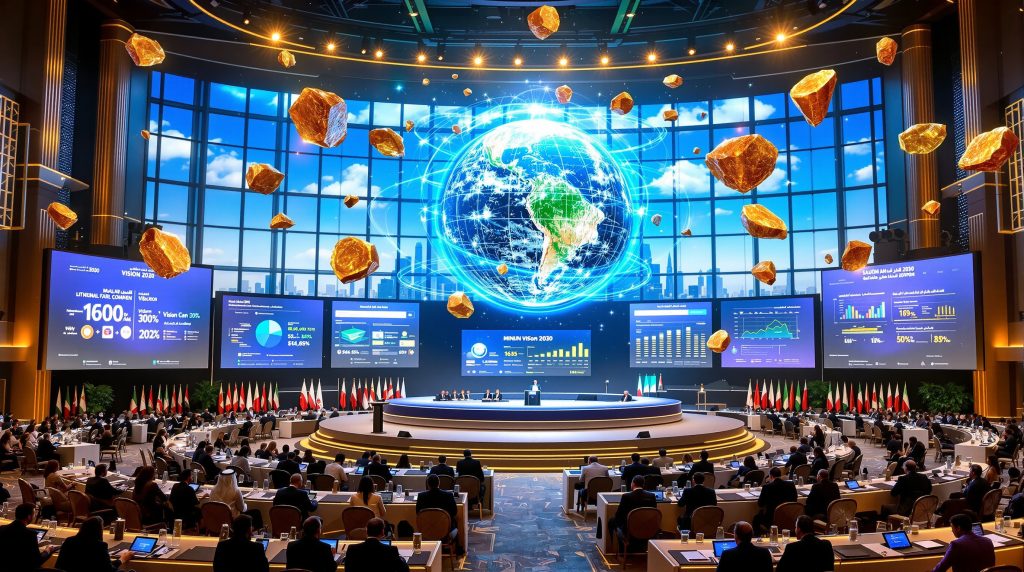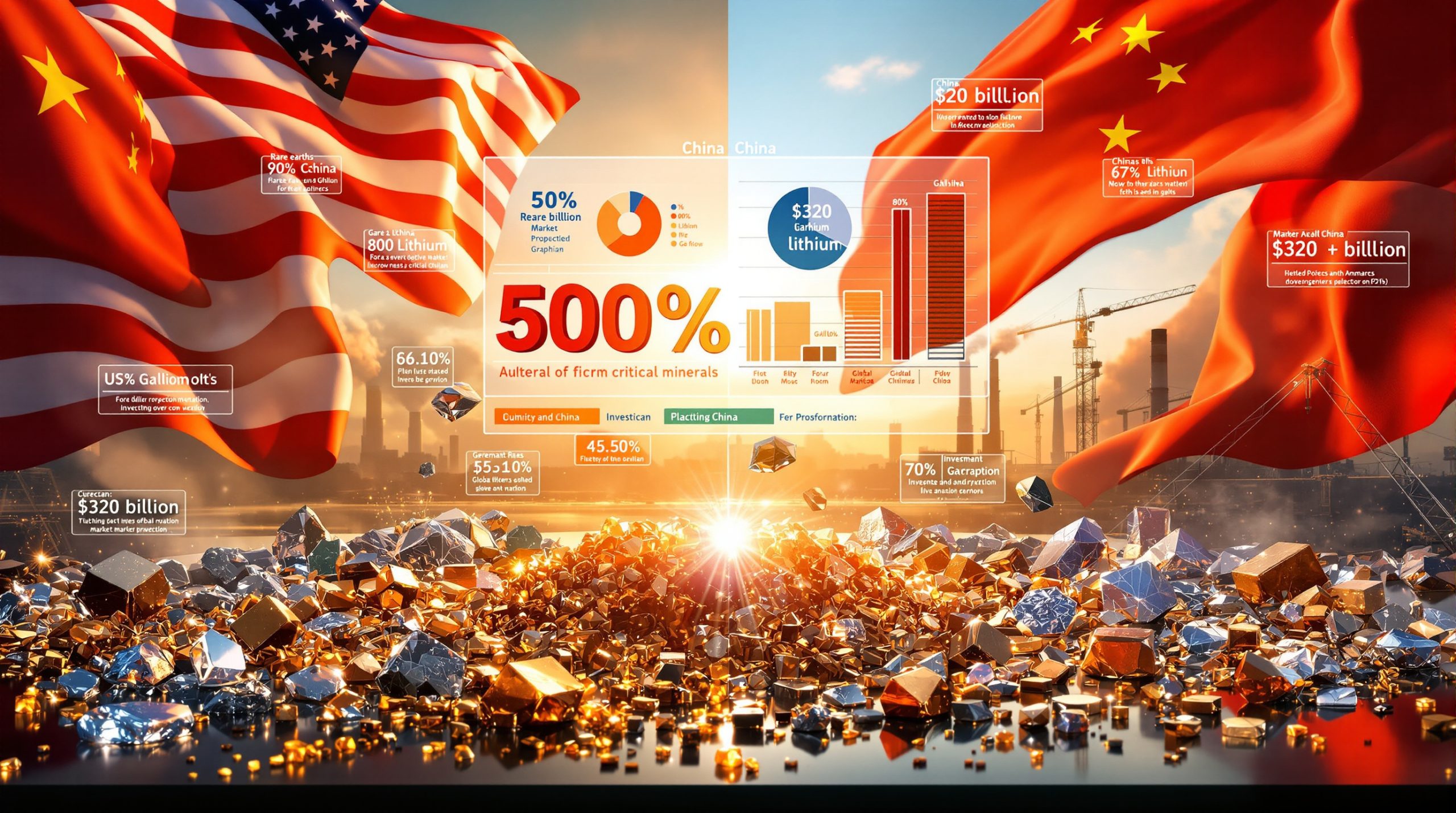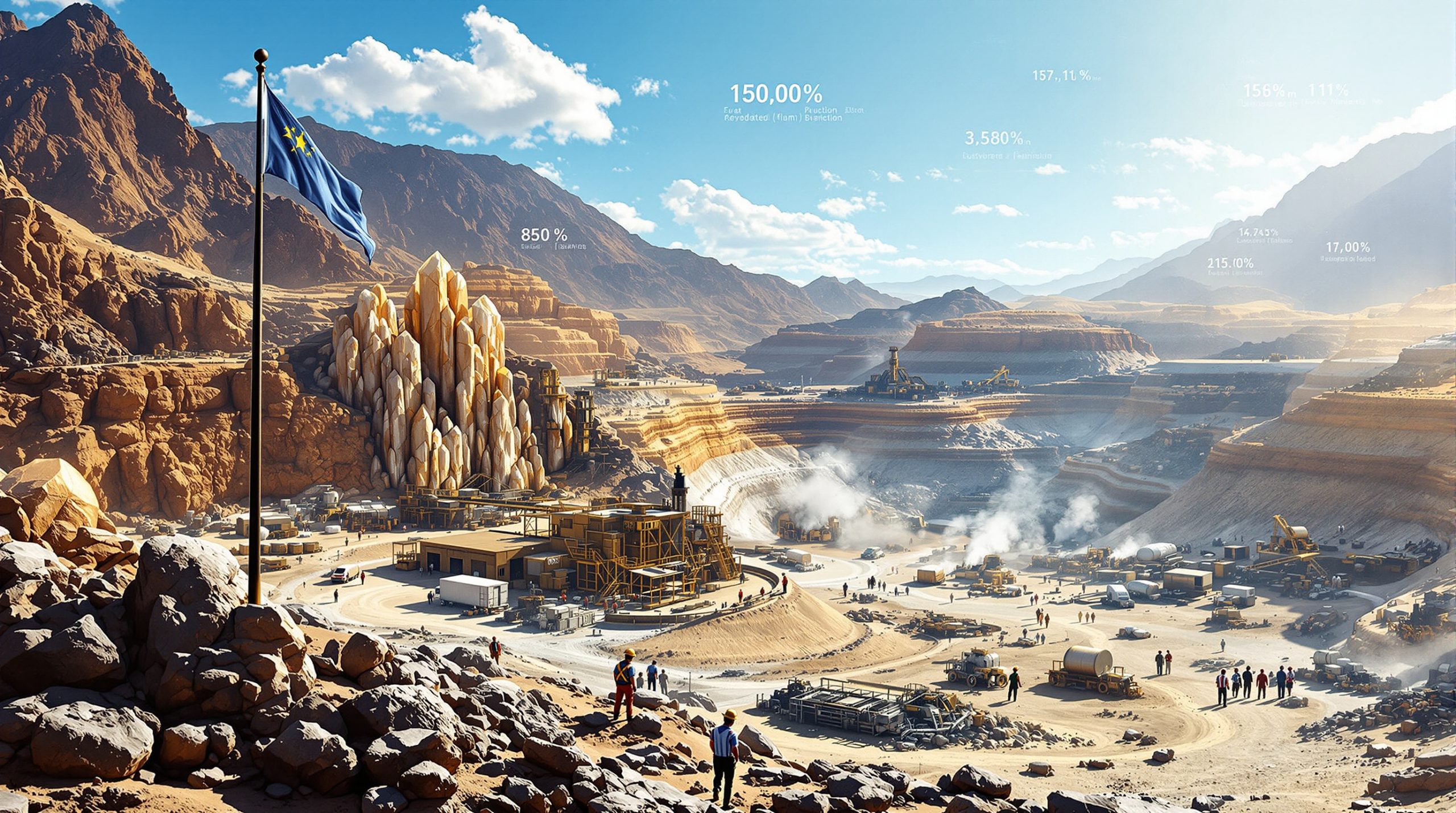Understanding the Global Minerals Summit
The Future Minerals Forum has emerged as a pivotal platform addressing worldwide mineral challenges through strategic dialogue and international cooperation. This annual gathering in Riyadh, Saudi Arabia, creates a unique ecosystem where diverse stakeholders converge to tackle supply chain vulnerabilities and accelerate sustainable resource development.
With over 13,000 attendees from more than 170 countries participating in the 2024 edition, the forum has established itself as one of the world's most significant minerals conferences. The event featured more than 500 speakers across 200+ sessions, demonstrating the scale and complexity of global mineral discussions taking place.
The forum operates through multiple specialised tracks including policy forums, investment summits, innovation showcases, and bilateral meeting programmes designed to facilitate concrete partnerships between stakeholders. This structure enables direct connections between mineral-rich countries and consuming nations, creating pathways for sustainable resource development.
The Strategic Importance of Critical Minerals in 2025
Modern economies depend heavily on specific minerals essential for renewable energy infrastructure, digital technologies, and national security applications. The forum addresses growing concerns about supply concentration, geopolitical risks, and the urgent need for critical minerals energy security and diversified sourcing strategies.
According to the International Energy Agency's Global Critical Minerals Outlook 2024, lithium demand for clean energy technologies is projected to increase by over 40 times by 2040 under sustainable development scenarios. Similarly, graphite, cobalt and nickel demand would increase by approximately 20-25 times, while rare earth elements demand would increase by 3-7 times depending on specific elements.
The strategic importance of these materials becomes clear when considering their applications:
- Lithium powers electric vehicle batteries and grid-scale energy storage
- Cobalt enables high-performance battery cathodes for electronics and vehicles
- Rare earth elements drive wind turbine magnets and electric motor efficiency
- Copper provides essential electrical conductivity for renewable energy systems
- Graphite serves as anode material in lithium-ion batteries
Innovation Partnerships and Technological Advancement
The forum serves as a catalyst for breakthrough technologies in mineral extraction, processing, and supply chain management. Furthermore, the emphasis on mining technology innovation represents a core component of the summit's value proposition.
The integration of government policy-makers at ministerial level creates direct pathways between policy formulation and industry implementation. Consequently, this distinguishes the forum from traditional mining conferences that focus primarily on industry participants.
Partnership Frameworks for Global Collaboration
The forum facilitates various partnership structures designed to address different aspects of mineral development challenges:
Government-to-Government Cooperation: Policy alignment and trade agreements that streamline regulatory frameworks across jurisdictions. These partnerships focus on creating predictable investment environments and reducing bureaucratic barriers to mineral project development.
Industry Alliance Formation: Technology sharing arrangements and joint venture structures that accelerate project development. Companies leverage complementary expertise and resources to tackle complex mining challenges that individual entities cannot address alone.
Investment Consortium Development: Capital mobilisation initiatives for large-scale projects that require substantial upfront investment. These frameworks enhance funding accessibility for projects that might otherwise struggle to secure adequate financing.
Research Collaboration Networks: Innovation partnerships targeting sustainability initiatives and technological breakthroughs. Academic institutions, government research bodies, and private companies combine resources to advance mineral processing technologies and environmental management practices.
Saudi Arabia's Strategic Mineral Vision
Saudi Arabia's transformation from an oil-dependent economy to a diversified minerals powerhouse demonstrates how nations can leverage geological advantages for sustainable growth. The kingdom's strategic positioning connects Asian demand centres with African supply regions through advanced infrastructure development.
Economic Diversification Through Resource Development
Under Vision 2030, Saudi Arabia aims to increase the mining sector's contribution to GDP from approximately $17 billion to $75 billion by 2030. This ambitious target reflects the kingdom's commitment to economic diversification and its confidence in domestic mineral resources.
The Kingdom has identified over $1.3 trillion worth of untapped mineral resources, including more than 50 types of minerals such as gold, copper, zinc, phosphate, and rare earth elements. These geological assets provide the foundation for the country's mineral sector expansion strategy.
To support this transformation, Saudi Arabia announced plans to invest over $182 billion in mining sector infrastructure by 2030 as part of Vision 2030. This massive investment programme encompasses transportation networks, processing facilities, and specialised logistics infrastructure.
Additionally, the Saudi exploration licenses framework provides a clear example of how jurisdictions can attract international investment while maintaining sovereign control over mineral resources.
Infrastructure Development Supporting Mineral Value Chains
The forum highlights infrastructure investments designed to create seamless logistics networks that enhance regional competitiveness:
- Saudi Landbridge Railway Project: Connecting the Arabian Gulf to the Red Sea, facilitating efficient mineral transport between Asia and global markets
- King Abdullah Port Expansion: Developing specialised facilities for mineral exports with enhanced handling capabilities
- Industrial Cities Development: Designated zones for mineral processing and value-addition activities that create downstream economic opportunities
- Processing Facility Networks: Strategic placement of refineries and processing plants to maximise value extraction from raw materials
The Ma'aden expansion represents a concrete example of Vision 2030 implementation, with multi-billion dollar investments in phosphate, aluminium, and gold production facilities that demonstrate the practical application of strategic planning.
Critical Minerals Driving Energy Transition
The transition to renewable energy requires unprecedented quantities of specific minerals, creating both opportunities and challenges for global supply chains. Current mining project pipelines fall short of meeting projected 2030 demand by approximately 30-50% for lithium and 10-20% for nickel and cobalt, highlighting the urgent need for new projects.
Essential Elements for Electrification
The transformation to clean energy technologies demands mineral inputs at scales never before experienced. The global lithium market, valued at approximately $7.5 billion in 2023, is projected to reach $15.4 billion by 2030, reflecting the explosive growth in electric vehicle adoption and energy storage deployment.
The supply chain dynamics for these critical minerals reveal concerning concentration patterns:
- China controls approximately 60% of global rare earth element production and 85% of rare earth processing capacity
- Democratic Republic of Congo produces 70% of global cobalt, raising supply security concerns for battery manufacturers
- Lithium refining is concentrated in China (60%), Chile (30%), and Argentina (10%), creating potential bottlenecks in supply chains
Supply Chain Vulnerabilities and Solutions
The forum addresses critical bottlenecks in mineral supply chains through comprehensive analysis of systemic risks:
Geographic Concentration Risks: Over-reliance on specific producing regions creates vulnerability to political instability, natural disasters, and trade disputes that can disrupt global supply chains.
Processing Capacity Limitations: Even when raw materials are available, insufficient refining capacity creates bottlenecks between mining and manufacturing stages of value chains.
Transportation Infrastructure Gaps: Inadequate connections between mining regions and processing facilities or export terminals limit the ability to move materials efficiently through global markets.
Regulatory Barriers: Inconsistent permitting processes and environmental standards across jurisdictions slow project development timelines and increase investment uncertainty.
Emerging Markets and Mineral Development
Africa holds approximately 30% of global mineral reserves, including 80% of platinum group metals, 60% of cobalt, and 50% of manganese. The continent's mineral endowment positions it as a critical supplier for global energy transition needs, though infrastructure and governance challenges require ongoing attention.
Africa's Growing Role in Global Supply Chains
The African mining sector contributed approximately $406 billion to continental GDP in 2023, demonstrating the economic significance of mineral resources for regional development. Mining exploration investments in Africa reached $1.1 billion in 2023, representing 11% of global exploration budgets and indicating growing investor confidence in the continent's mineral potential.
African nations are positioning themselves as reliable suppliers through improved governance frameworks and infrastructure development facilitated by international partnerships. The African Union's Africa Mining Vision framework emphasises knowledge-driven, sustainable and equitable mining that maximises local value addition while minimising environmental impacts.
Technology Transfer and Capacity Building Initiatives
The forum promotes knowledge sharing programmes that help developing nations build local expertise across multiple dimensions:
- Geological Surveying Capabilities: Advanced techniques for resource assessment and exploration targeting
- Mining Operations Management: Best practices for efficient and safe extraction processes
- Environmental Management Systems: Frameworks for minimising ecological impact and ensuring regulatory compliance
- Community Engagement Protocols: Methods for ensuring local stakeholder participation and benefit sharing
The African Minerals Development Centre, established by the African Union, provides technical assistance to member states on policy development, contract negotiation, and geological surveying capacity building. This institution represents a concrete example of South-South cooperation in mineral sector development.
Several African nations have updated mining codes and regulatory frameworks to attract investment while ensuring appropriate government revenue sharing. The Democratic Republic of Congo revised its mining code in 2018 and again in 2023, Tanzania implemented new mining regulations requiring local content and value addition, and Botswana's diamond beneficiation strategy requires a percentage of production to be cut and polished domestically.
Investment Opportunities and Financial Frameworks
Global mining exploration budgets reached $12.2 billion in 2023, up 10% from 2022, indicating growing investor confidence in mineral sector opportunities. Critical minerals projects attracted approximately $45 billion in new investment commitments globally in 2023, reflecting the strategic importance of securing reliable supply chains.
Major Deal Structures and Financial Frameworks
Mining project financing typically involves sophisticated structures designed to manage various risk categories:
Equity Financing Components: Major mining companies and private equity funds provide development capital in exchange for ownership stakes and operational control rights.
Project Finance Debt Arrangements: Commercial banks and development finance institutions offer long-term lending secured by project assets and revenue streams.
Off-take Agreement Integration: Revenue certainty through long-term purchase contracts with end-users, particularly important for critical mineral projects serving specific industrial applications.
Political Risk Insurance Coverage: Protection from multilateral agencies against government actions that could impair investment returns or project viability.
The effective implementation of these financing structures requires a comprehensive critical minerals strategy that aligns government policy objectives with private sector investment incentives.
Risk Mitigation Strategies for International Investors
The Organisation for Economic Co-operation and Development emphasises that mining investments in developing countries require comprehensive risk assessment covering political stability, regulatory certainty, infrastructure adequacy, and social licence to operate.
Effective risk management frameworks incorporate multiple layers of protection:
- Diversified Investment Portfolios: Spreading risk across multiple projects, commodities, and geographic regions
- Comprehensive Insurance Products: Coverage for political, operational, and market risks through specialised insurance providers
- Multilateral Development Bank Participation: Leverage institutional expertise and policy influence of organisations like the World Bank Group and regional development banks
- Local Partnership Structures: Joint ventures with domestic companies that provide local knowledge and stakeholder relationships
The International Finance Corporation committed approximately $1.2 billion to mining and minerals projects in emerging markets in fiscal year 2023, focusing on sustainable and responsible operations that meet international environmental and social standards.
Furthermore, successful investment strategy components must consider the unique characteristics of mineral markets, including long development timelines and commodity price volatility.
Environmental and Social Governance Framework
Modern mining operations using advanced water recycling technologies can reduce freshwater consumption by 30-50% compared to conventional methods. The mining sector accounts for approximately 2-3% of global energy consumption, making efficiency improvements and renewable energy adoption crucial for sector sustainability.
Sustainable Mining Practices and Standards
Environmental stewardship requires integration across all aspects of mining operations:
Water Management Technologies: Advanced recycling systems, closed-loop processing, and treatment facilities that minimise freshwater consumption and eliminate contaminated discharge.
Renewable Energy Integration: Solar, wind, and hybrid power systems that reduce operational carbon footprints while potentially lowering energy costs in remote mining locations.
Biodiversity Protection Protocols: Comprehensive baseline assessments, habitat restoration programmes, and offset mechanisms that achieve no net loss of ecological value in sensitive areas.
Community Engagement Frameworks: Stakeholder consultation processes, benefit-sharing agreements, and local employment programmes that ensure mining activities contribute to regional development.
Leading mining companies have committed to net-zero emissions by 2050, with interim 2030 targets ranging from 30-50% reductions in greenhouse gas emissions. These commitments require substantial operational changes and technology adoption across the industry.
Circular Economy Applications in Mineral Processing
The forum explores innovative approaches to mineral recycling, waste reduction, and byproduct utilisation that create additional revenue streams while minimising environmental impact:
- Tailings Reprocessing: Advanced technologies for extracting additional valuable minerals from historical waste materials
- Water Circuit Optimisation: Closed-loop systems that eliminate discharge requirements and reduce freshwater consumption
- Energy Recovery Systems: Waste heat utilisation and process optimisation that improves overall energy efficiency
- Byproduct Valorisation: Finding commercial applications for materials previously considered waste products
Key environmental and social governance frameworks applicable to the mining sector include the Initiative for Responsible Mining Assurance Standard, Responsible Minerals Initiative supply chain due diligence standards, Task Force on Climate-related Financial Disclosures reporting requirements, and Global Reporting Initiative mining and metals sector standards.
The Extractive Industries Transparency Initiative promotes transparency in mining sector payments and revenues, with 57 implementing countries publishing detailed reports on mining revenues and their distribution to local communities.
Key Outcomes and Future Directions
Global critical mineral supply chain resilience has become a policy priority, with over 30 countries developing critical minerals strategies between 2020-2024. This policy focus reflects growing recognition that mineral security represents a fundamental component of economic and national security.
Measurable Impact on Global Mineral Security
The Future Minerals Forum's influence extends beyond networking opportunities, creating pathways for tangible improvements in supply chain resilience, price stability, and technological advancement across the minerals sector. Government-to-government partnerships formed through forum discussions enable policy coordination that reduces regulatory uncertainty for international mining investments.
Industry alliance formation facilitated by the forum creates opportunities for technology transfer, risk sharing, and capital mobilisation that individual companies cannot achieve independently. These collaborative structures particularly benefit complex projects requiring substantial upfront investment and specialised technical expertise.
2026 Priorities and Emerging Themes
Future forum editions will likely address emerging technologies and applications that could transform mineral demand patterns:
Space Mining Technologies: While commercial viability remains decades away, ongoing research into asteroid and lunar resource extraction could eventually supplement terrestrial mineral supplies. Current technology and economic conditions make space mining commercially unfeasible, but continued research may identify breakthrough applications.
Deep-Sea Mineral Extraction: The International Seabed Authority continues developing regulatory frameworks for seabed mineral exploitation, though no commercial mining licences have been issued as of 2024. Environmental concerns and incomplete scientific understanding of deep-sea ecosystems continue to delay regulatory finalisation.
Artificial Intelligence Applications: Machine learning algorithms for geological exploration, ore grade optimisation, and predictive maintenance could significantly improve mining efficiency and reduce operational costs. These technologies show immediate practical application potential compared to more speculative space and deep-sea mining concepts.
Recycling Technology Advancement: Urban mining and advanced recycling technologies could provide substantial mineral supplies from existing infrastructure and waste streams, reducing pressure on primary mining operations while creating circular economy opportunities.
The Future Minerals Forum continues to evolve as a critical platform for addressing these complex challenges through international cooperation and strategic dialogue.
Frequently Asked Questions About the Future Minerals Forum
Who Should Attend the Future Minerals Forum?
Based on 2024 attendee composition, the forum attracts a diverse mix of stakeholders including government officials and policymakers (approximately 25% of attendees), mining company executives (approximately 35%), investors and financial institutions (approximately 20%), technology and service providers (approximately 15%), and others including academia, NGOs, and media (approximately 5%).
The forum particularly benefits individuals and organisations seeking to influence global mineral policy, form international partnerships, or understand emerging trends in critical mineral markets. Government officials can engage directly with industry leaders, while investors can assess opportunities across multiple jurisdictions and commodity types.
How Does the Forum Impact Mineral Prices?
While the forum does not directly set mineral prices, discussions and partnership announcements often influence market sentiment and long-term supply expectations. Investment commitments announced at the forum can affect commodity valuations by signalling future supply availability and demand patterns.
The forum's focus on supply chain diversification and new project development provides market participants with insights into medium-term supply scenarios that may not be reflected in current pricing. Policy discussions can also signal regulatory changes that could affect production costs or market access conditions.
What Makes This Forum Different from Other Mining Conferences?
The forum's unique government-industry-investor integration creates policy-level discussions that can translate into actionable agreements, distinguishing it from traditional mining conferences that focus primarily on industry networking and technical presentations.
The ministerial-level participation enables direct policy dialogue between resource-producing and resource-consuming countries. This creates opportunities for bilateral agreements and regulatory coordination that purely industry-focused conferences cannot facilitate.
Disclaimer: This article contains forward-looking statements and projections based on current market conditions and policy frameworks. Mineral markets are subject to significant volatility, and investment decisions should be based on comprehensive due diligence and professional financial advice. Projected demand increases and investment opportunities discussed represent estimates that may not materialise due to technological, economic, or regulatory changes.
Looking to Capitalise on Critical Mineral Discoveries?
Discovery Alert's proprietary Discovery IQ model delivers instant notifications on significant ASX mineral discoveries, helping investors identify actionable opportunities in critical minerals before the broader market catches on. Explore Discovery Alert's discoveries page to see how major mineral discoveries have generated substantial returns historically, then begin your 30-day free trial to position yourself ahead of the market in this rapidly evolving sector.




